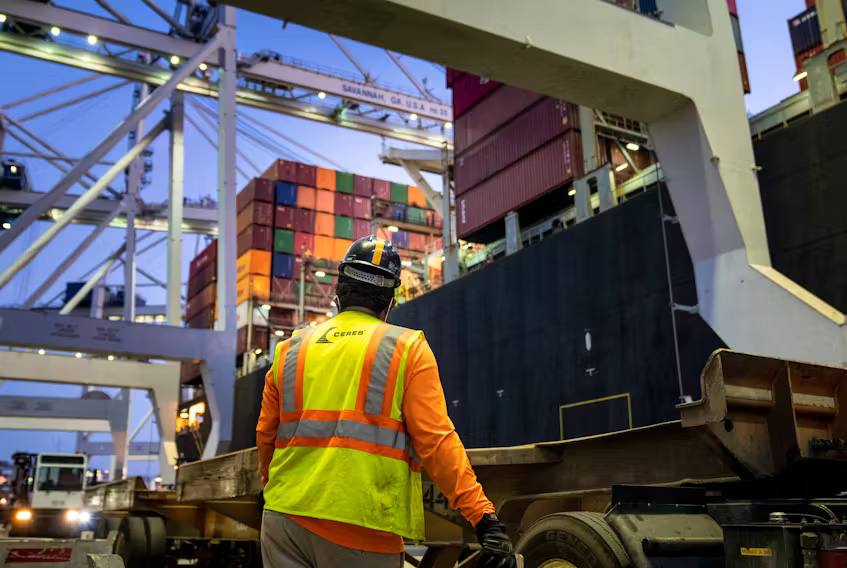
By Peter Eavis
East and Gulf coast longshoremen are poised to strike today, potentially halting operations at some of the nation’s busiest ports if negotiations between their union and employers do not resolve a protracted dispute over a new labor agreement.
A walkout by the International Longshoremen’s Association members would lead to daily economic losses amounting to billions of dollars.
President Joe Biden has the authority to invoke a federal labor law to mandate that longshoremen return to work; however, he stated on Sunday that he was not contemplating that course of action. In recent days, high-ranking government officials have been urging both parties to come to an agreement.
“The prospect of a strike is undesirable for both the Biden administration and the economy,” said Harley Shaiken, an emeritus professor at the University of California, Berkeley, specializing in trade and labor matters. “However, it appears likely to take place.”
The ILA, comprising 47,000 members, has not conducted a strike at all East and Gulf coast ports since 1977. The union and the United States Maritime Alliance, representing the employers, are in a deadlock over wage increases and benefits. Additionally, the union is opposed to the implementation of automated machinery at the ports.
Recently, major unions, including the Teamsters and the United Automobile Workers, have achieved significant gains in their contract negotiations. The longshoremen find themselves in an even stronger bargaining position.
There are no viable alternatives to the East and Gulf coast ports for transporting numerous goods in and out of the eastern United States. The ports rely on longshoremen to handle shipping containers and other vital cargo, such as automobiles and heavy equipment.
At a union gathering at Yankee Stadium in New York last Friday, more than a dozen ILA members expressed their support for a strike.
In anticipation of a strike, many businesses have placed orders earlier than usual to ensure their goods clear the East and Gulf coast ports before Tuesday. However, much of the cargo has not been processed in time and could remain stranded at sea. Even if a strike is brief, it may take weeks to resolve the resulting backlog.
John Wrenn, chief operating officer of MHW, a beverage distributor in Manhasset, New York, fears that a strike could impede shipments, leaving his business unprepared as Thanksgiving approaches.
“These are significant sales opportunities that will be lost because products won’t be available on the shelves,” he remarked. MHW imports over 2,000 containers annually through the Port of New York and New Jersey, which ranks as the third busiest port in the country.
The ILA has indicated that a strike would not impact work on cruise ships. At the Port of New York and New Jersey, essential bulk food items, including edible oils and orange juice, will remain unaffected. However, other food imports might be halted, resulting in shortages if a strike persists.
Stefanie Katzman, executive vice president of S. Katzman Produce, a produce supplier in the Bronx, is particularly worried about the potential spoilage of mangos imported from Brazil if they remain stranded at sea. She is contemplating the costly option of flying some mangos in, stating, “There’s a substantial difference in capacity for flying products compared to shipping them by boat.”
West Coast ports will remain operational because their longshoremen belong to a different union, which secured a new contract last year. Although some shipments are being rerouted there, leading to increased activity, those ports cannot accommodate all cargo that typically moves through East and Gulf coast ports, which handle three-fifths of U.S. container traffic. Moreover, businesses assert that transporting cargo from West Coast ports to the East Coast via trucks or trains is prohibitively expensive for many items and destinations.
The ILA ceased contract discussions in June, citing the discovery of labor-saving technology at the port in Mobile, Alabama. This technology, employed for truck processing at the port, has been in operation since its opening in 2008, as noted by a source familiar with the port. Last week, the Maritime Alliance petitioned the National Labor Relations Board to compel the ILA to recommence negotiations, though it may take several weeks for the board to address the alliance’s claims following its investigation.
Harold J. Daggett, the president of the union, has shifted the ILA’s focus towards wage issues, asserting that the raises proposed by the Maritime Alliance are “degrading.”
Currently, under the contract set to expire on Monday, longshoremen earn a maximum rate of $39 per hour. The ILA is requesting a $5-per-hour increase for each of the six years of the new contract, ultimately raising their rate to $69 per hour by the contract’s conclusion. In contrast, the pay for longshoremen on the West Coast will escalate to $60.85 per hour by 2027, the final year of their agreement.
Including overtime and shift work, longshoremen’s annual earnings can exceed $200,000; however, they indicate that achieving that income necessitates extensive work weeks.
